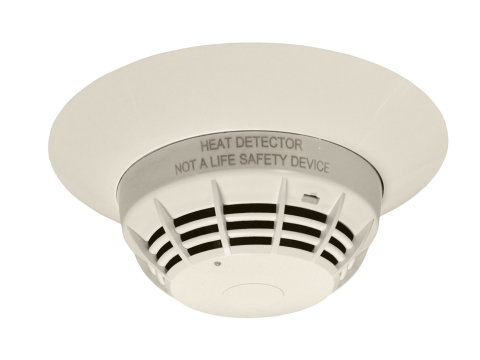Fire alarm systems hinge on specialized sensors—often called “detectors”—that look for early signs of a blaze: heat, smoke, or open flame. These sensors are also critical in automatic fire suppression setups. While there are multiple detector types, the most common are:
- Smoke Detectors
- Heat Detectors
- Flame Detectors
Each style is designed to recognize a specific fire byproduct—smoke particles, rising temperatures, or visible flames. Below, we focus on smoke and heat sensors, diving into how they operate, where they excel, and what to consider when selecting and installing them.
Smoke Detectors in Fire Alarm Systems
Smoke is often the first indicator of a fire, especially in environments with electronics, plastics, and synthetic materials. That’s why smoke detectors are the most widespread in commercial buildings, offices, and residential properties. They generally measure the optical density of the air (i.e., how “cloudy” it is). If the density surpasses a threshold, they trigger an alarm.
Spot vs. Line-Type Smoke Detectors
Spot (Point) Detectors
- Encased in a single housing with:
- Smoke Chamber (Labyrinth)—where an infrared beam travels between an emitter and a receiver
- Signal Processing Circuit—analyzes changes in IR intensity
- Mounting Hardware
- Each sensor monitors a single point in space. Thus, larger rooms often require several detectors based on standards like NFPA 72 (in the US) or local equivalents.
- Encased in a single housing with:
Line (Beam) Detectors
- Use infrared beams that span across the monitored area (e.g., 50–300 feet/15–100 meters).
- Consist of an emitter and a receiver—either as separate units facing each other or as a combined unit with a reflector on the opposite wall.
- Ideal for high-ceiling spaces (warehouses, atriums) where smoke may dilute before reaching point detectors.
- Mounted on walls rather than ceilings, in contrast to point sensors.
Important: Smoke sensors can be prone to false alarms if exposed to heavy dust or steam. In these tough conditions, heat detectors may be more suitable.
Heat Detectors in Fire Alarm Systems
Heat detectors look for abnormal temperature rises. They’re less sensitive to smoldering, smoky fires but excel in dusty or high-ceiling spaces where smoke may dissipate before triggering a standard smoke detector.
Types of Spot Heat Detectors
Fixed-Temperature (Maximum)
- Trips at a predetermined threshold (often around 135–160°F / 57–71°C).
- Some use a fusible alloy that melts under excessive heat, causing a permanent circuit break. These are one-time-use but are durable and suitable for harsh or even potentially explosive environments.
Rate-of-Rise (Differential)
- Reacts to a rapid temperature increase over a specific timeframe (e.g., 3–30°F per minute).
- More responsive to fast-growing fires than fixed-temperature detectors alone.
Combination (Rate-of-Rise + Fixed)
- Integrate both principles for early warning of sudden temperature spikes while retaining the fixed-threshold backup.
Installation
Spot heat detectors typically mount on ceilings—number and spacing can reference NFPA 72 or local codes. Positioning depends on ceiling height, potential airflow (which can cool or disperse heat), and the detector’s UL-listed coverage radius.
Line (Linear) Heat Detectors
- Thermal-Sensing Cable that changes resistance or capacitance upon reaching a certain temperature.
- Ideal for long enclosures like cable trays, elevator shafts, or tunnels.
- The cable can trace the entire route needing protection, triggering alarms if any segment overheats.
Addressable vs. Conventional Detectors
Conventional (Non-Addressable)
- Each detector signals by opening or closing contacts in the alarm circuit.
- Cheaper, simpler, but lack detailed location info.
Addressable
- Each sensor has a unique digital address.
- Panels display or log the exact location of each triggered sensor, speeding up emergency response.
- Often used in larger commercial or institutional buildings.
Addressable-analog detectors can also monitor multiple parameters—such as heat and smoke levels—simultaneously, enabling early detection of different fire scenarios and reducing nuisance alarms.
Selecting the Right Sensor
- Environment
- Office or retail spaces with synthetic materials: heavy smoke generation => smoke detectors are best.
- Dusty or harsh environments (e.g., warehouses): heat detectors or specialized “dust-proof” smoke models.
- Ceiling Height
- > 10 ft (3 m): beam-style smoke sensors or specialized high-ceiling detectors.
- Tall or open structures: consider layered detection (spot + beam).
- Fire Load & Fuel Types
- Some materials burn quickly with intense heat but minimal smoke => rate-of-rise or fixed-temperature heat detectors.
- Others (plastics, electronics) produce significant smoke at early stages => smoke detectors.
Beyond Fire Detection: Dual-Use Scenarios
Certain thermal detectors can also serve as intrusion sensors. For instance, metal safes or ATM machines can be protected from torch attacks with heat sensors that detect an abnormally high temperature, triggering an alarm before extensive damage occurs.
Conclusion
Smoke and heat detectors are fundamental to any robust fire alarm system. Smoke detectors are typically the first line of defense in office or residential settings—especially those prone to smoldering fires—while heat detectors shine in dusty or high-ceiling facilities and for applications requiring direct monitoring of temperature rises.
Key Points:
- Spot (Point) vs. Line (Beam): Choose based on ceiling height, room size, and environmental conditions.
- Fixed-Temperature vs. Rate-of-Rise: Select the heat detection principle that best suits your facility’s potential fire hazards.
- Addressable detectors add enhanced diagnostics and precise location pinpointing, invaluable in larger installations.
- Code Compliance (e.g., NFPA 72 in the US) and local regulations guide the design and placement of fire detectors.
For more tailored advice on selecting, installing, and integrating smoke or heat detectors into a comprehensive fire alarm system, visit safsale.com. Our experts can help you ensure optimal coverage, compliance with local building codes, and minimal false alarms—safeguarding both lives and property.

